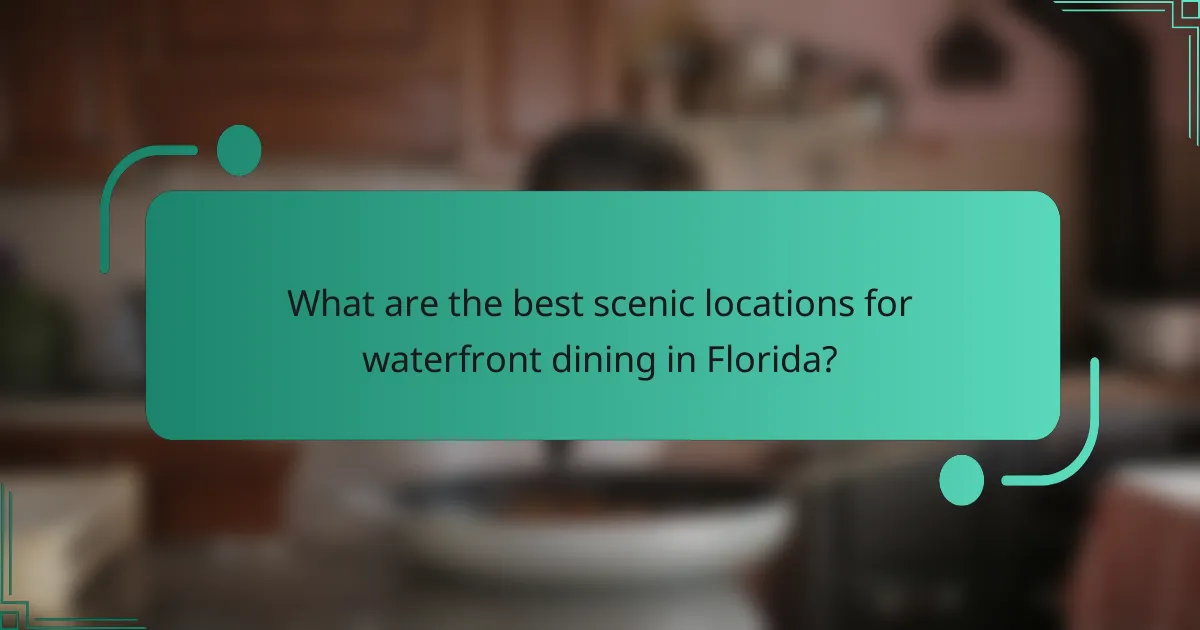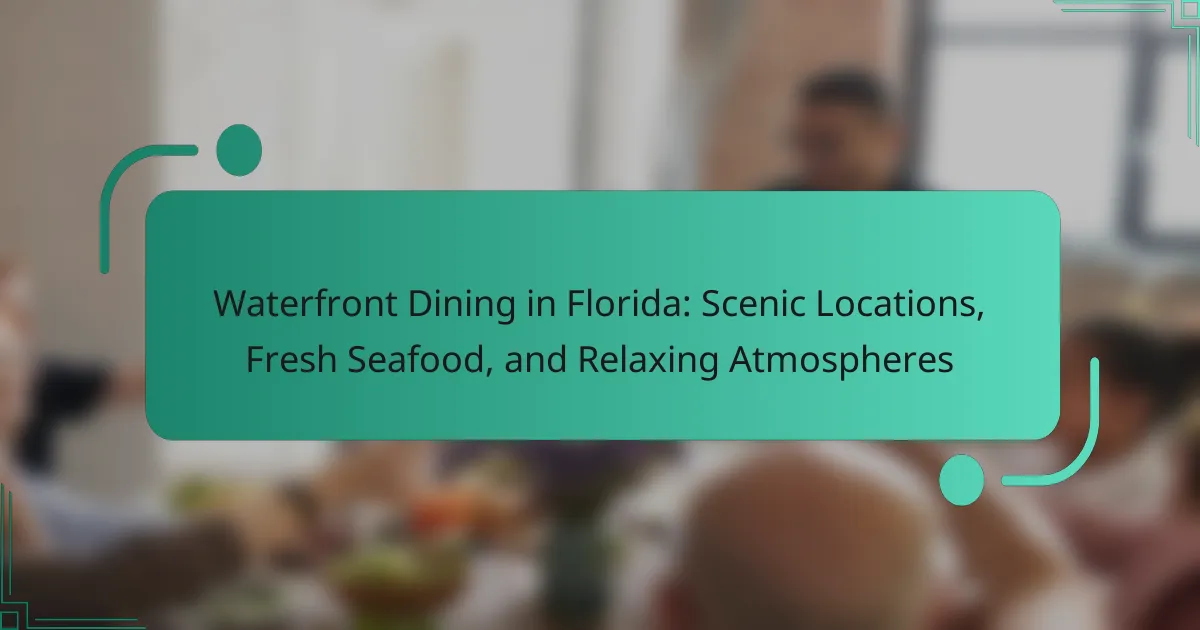Waterfront dining in Florida encompasses restaurants situated along the state’s coastlines, rivers, and lakes, offering patrons scenic views and fresh seafood. Key locations for this dining experience include Clearwater Beach, Key West, and Naples, each providing unique atmospheres and picturesque settings. Diners can expect a variety of seafood options, such as grouper, snapper, and shrimp, sourced locally to ensure freshness. The tranquil ambiance, enhanced by natural elements and outdoor seating, promotes relaxation and enjoyment while savoring meals by the water. Overall, Florida’s waterfront dining scene combines stunning views, quality cuisine, and a soothing atmosphere, making it a popular choice for both locals and tourists.

What is Waterfront Dining in Florida?
Waterfront dining in Florida refers to eating establishments located along the state’s coastlines, rivers, or lakes. These venues offer scenic views of water bodies, enhancing the dining experience. Many waterfront restaurants specialize in fresh seafood, reflecting Florida’s rich maritime culture. Patrons often enjoy outdoor seating to fully appreciate the natural surroundings. The ambiance is typically relaxed, attracting both locals and tourists. Florida’s diverse ecosystems provide a unique backdrop for these dining experiences. Popular areas for waterfront dining include Miami, Tampa, and Key West. These locations frequently feature live music and events, further enriching the atmosphere.
How does waterfront dining enhance the dining experience?
Waterfront dining enhances the dining experience by providing scenic views and a relaxing atmosphere. Patrons enjoy the visual appeal of water, which promotes a sense of tranquility. Studies indicate that natural landscapes, including water views, can reduce stress and improve mood. The combination of fresh seafood and picturesque surroundings creates a unique culinary experience. Additionally, the sound of water can enhance the ambiance, making meals more enjoyable. Research shows that dining in pleasant environments can lead to longer visits and increased satisfaction. Overall, waterfront dining offers a holistic experience that engages multiple senses.
What are the key features of waterfront dining venues?
Waterfront dining venues are characterized by their scenic views, proximity to water, and unique ambiance. These venues typically offer outdoor seating to enhance the dining experience. Many feature fresh seafood as a primary menu item, reflecting local culinary traditions. The atmosphere is often relaxed and casual, inviting patrons to enjoy their meals at a leisurely pace. Additionally, waterfront dining venues may provide live entertainment, such as music or events, which enhances the overall experience. Many are designed with large windows or open layouts to maximize water views. Seasonal decorations and themes are common, aligning with the natural surroundings. These features collectively create a memorable dining experience that attracts both locals and tourists.
How does the location impact the atmosphere of waterfront dining?
The location significantly impacts the atmosphere of waterfront dining. Proximity to water creates a unique ambiance. Scenic views enhance the dining experience. Natural light contributes to a relaxed environment. The sound of waves adds to the sensory experience. Locations with vibrant marine life attract more visitors. Seasonal weather influences outdoor dining preferences. Aesthetic surroundings can elevate the overall enjoyment of meals.
Why is Florida known for its waterfront dining options?
Florida is known for its waterfront dining options due to its extensive coastline and vibrant marine culture. The state has over 8,400 miles of coastline, providing numerous scenic locations for dining. Many restaurants offer views of the ocean, lakes, and rivers. This enhances the dining experience with a picturesque backdrop. Florida’s warm climate allows for year-round outdoor dining. Fresh seafood is abundant, with local catches featured on many menus. The combination of beautiful scenery and fresh culinary offerings attracts both locals and tourists. This unique dining experience is a significant draw for visitors seeking relaxation and enjoyment by the water.
What geographical features contribute to Florida’s dining scene?
Florida’s geographical features significantly enhance its dining scene. The state has an extensive coastline, providing access to fresh seafood. This proximity to the ocean allows restaurants to serve a variety of local fish and shellfish. Florida’s warm climate supports year-round outdoor dining. Many establishments take advantage of scenic waterfront locations. The presence of numerous lakes and rivers adds to the diversity of dining experiences. Additionally, the state’s unique ecosystems, such as the Everglades, influence local cuisine. The blend of cultural influences from nearby regions also enriches Florida’s culinary offerings.
How does Florida’s climate affect outdoor dining experiences?
Florida’s climate significantly influences outdoor dining experiences. The state is known for its warm temperatures and high humidity, particularly during summer months. These conditions can create a pleasant atmosphere for dining, encouraging patrons to enjoy meals outside. However, the heat can also lead to discomfort without adequate shade or cooling options. Rain is common in the summer, which may disrupt outdoor dining plans.
The mild winters allow for year-round outdoor dining opportunities. According to the National Oceanic and Atmospheric Administration, Florida averages 237 sunny days per year, making it ideal for outdoor dining. Additionally, the coastal breeze can enhance comfort levels during warmer days. Overall, Florida’s climate offers both advantages and challenges for outdoor dining experiences.

What are the best scenic locations for waterfront dining in Florida?
The best scenic locations for waterfront dining in Florida include Clearwater Beach, Key West, and Naples. Clearwater Beach offers stunning sunsets and fresh seafood restaurants like Frenchy’s Rockaway Grill. Key West features vibrant dining options with ocean views, such as Louie’s Backyard. Naples boasts upscale waterfront dining at places like The Dock at Crayton Cove. Each location provides a unique atmosphere and picturesque views, making them ideal for enjoying meals by the water.
Which cities in Florida are renowned for their waterfront dining?
Miami, St. Petersburg, and Sarasota are renowned for their waterfront dining in Florida. Miami offers a vibrant culinary scene along Biscayne Bay. St. Petersburg features numerous restaurants with views of the marina and waterfront parks. Sarasota is known for its waterfront eateries that showcase fresh seafood and stunning sunsets. These cities attract both locals and tourists seeking scenic dining experiences.
What unique views can diners expect in these cities?
Diners in Florida’s waterfront cities can expect stunning views of the ocean, bays, and rivers. These locations often feature picturesque sunsets reflecting on the water. Many restaurants offer panoramic vistas of sandy beaches and lush coastal landscapes. Diners may also enjoy views of boats and marine life, enhancing the dining experience. Iconic landmarks, such as lighthouses and piers, provide additional scenic backdrops. The vibrant colors of tropical flora surrounding the dining areas add to the visual appeal. Overall, the combination of natural beauty and waterfront activity creates a unique atmosphere for diners.
How do local attractions enhance the dining experience?
Local attractions enhance the dining experience by providing a scenic backdrop and cultural context. Waterfront views can elevate the ambiance of a meal, making it more enjoyable. Attractions nearby, such as parks or historic sites, add to the overall atmosphere. They can draw visitors to restaurants, increasing foot traffic and visibility. Engaging activities or events nearby can create a lively dining environment. Research shows that diners are willing to pay more for meals with picturesque views. The combination of good food and beautiful surroundings can lead to memorable experiences. This connection between attractions and dining can boost customer satisfaction and repeat visits.
What are some hidden gems for waterfront dining in Florida?
Some hidden gems for waterfront dining in Florida include The Fish House in Key Largo, known for its fresh seafood and beautiful views. Another is The Waterfront Grill in Naples, offering a relaxed atmosphere and stunning sunset views. Additionally, The Boathouse on the Bay in Fort Myers provides a unique dining experience with live music and waterfront seating. Each of these locations emphasizes local ingredients and a scenic dining experience, making them standout choices for visitors seeking waterfront dining in Florida.
What makes these locations special compared to popular spots?
These locations are special due to their unique waterfront views and tranquil environments. They offer a more serene dining experience compared to crowded popular spots. The fresh seafood served is often sourced locally, ensuring quality and flavor. Many of these locations provide immersive natural settings, enhancing the overall dining atmosphere. Additionally, they may feature less commercialized charm, attracting those seeking authenticity. The intimate ambiance fosters a relaxing experience, ideal for leisurely meals. Visitors can enjoy picturesque sunsets and scenic vistas, which are not typically found at busier venues. Such elements contribute to a memorable dining experience that stands out from mainstream options.
How can diners discover these lesser-known venues?
Diners can discover lesser-known venues through local food blogs and social media platforms. Many food bloggers highlight hidden gems in their communities. Social media platforms like Instagram and Facebook often feature posts from diners at these venues. Online review sites provide insights and ratings from patrons. Word of mouth from locals can lead to unique dining experiences. Local tourism boards may also promote lesser-known spots. Additionally, exploring areas off the beaten path can reveal hidden treasures. These methods encourage diners to venture beyond popular destinations.

What types of fresh seafood can be enjoyed at waterfront dining establishments?
Fresh seafood at waterfront dining establishments includes fish, shellfish, and crustaceans. Common fish varieties are grouper, snapper, and mahi-mahi. Shellfish options often feature oysters, clams, and mussels. Crustaceans typically include shrimp and crab. These seafood selections are usually sourced locally. Many waterfront restaurants prioritize fresh catches from nearby waters. This ensures high-quality and flavorful dishes. Dining by the water enhances the overall experience.
What are the most popular seafood dishes served in Florida’s waterfront restaurants?
The most popular seafood dishes served in Florida’s waterfront restaurants include blackened mahi-mahi, stone crab claws, and shrimp and grits. Blackened mahi-mahi is often seasoned with spices and grilled to perfection. Stone crab claws are a seasonal delicacy, typically served with mustard sauce. Shrimp and grits combine sautéed shrimp with creamy grits, making a hearty dish. Other favorites include fried calamari, oysters on the half shell, and clam chowder. These dishes showcase the freshness of local seafood. Waterfront locations enhance the dining experience with scenic views.
How do seasonal changes affect seafood availability?
Seasonal changes significantly affect seafood availability. Many fish and shellfish species have specific breeding and migration patterns tied to seasons. For example, certain species like snapper and grouper are more abundant in warmer months. Cold temperatures can reduce the catch of species like shrimp and crabs, as they become less active. Additionally, seasonal regulations often limit fishing to protect spawning populations. These regulations can further influence the availability of seafood throughout the year. Seasonal weather patterns, such as hurricanes, can also disrupt fishing activities, impacting supply. Overall, these factors lead to variations in the types and quantities of seafood available in different seasons.
What local seafood specialties should diners try?
Diners should try stone crab claws, a local delicacy in Florida. These claws are known for their sweet, tender meat. They are typically served cold with a mustard dipping sauce. Another specialty is grouper, often grilled or blackened. Grouper is a versatile fish that is popular in many Florida dishes. Additionally, diners should sample Key West pink shrimp. This shrimp is prized for its flavor and is often featured in shrimp cocktails or seafood platters. Lastly, conch fritters are a must-try. These deep-fried treats are made from conch meat and are a staple in Florida cuisine. Each of these specialties showcases the fresh seafood available along the Florida coast.
How do restaurants ensure the freshness of their seafood?
Restaurants ensure the freshness of their seafood through strict sourcing and storage practices. They often establish relationships with local fishermen and suppliers. This allows them to receive daily catches. Many restaurants inspect seafood upon delivery for quality and freshness. They also store seafood at proper temperatures to prevent spoilage. Some utilize ice or refrigeration to maintain optimal conditions. Additionally, restaurants may implement a first-in, first-out (FIFO) system for inventory management. This helps in using older stock first to ensure freshness. These practices are vital for serving high-quality seafood dishes.
What sourcing practices do waterfront restaurants use?
Waterfront restaurants often utilize local sourcing practices to ensure freshness. They frequently partner with nearby fishermen and seafood suppliers. This practice supports local economies and reduces transportation time. Many waterfront establishments also emphasize sustainable fishing practices. They may feature menus that change seasonally based on available catch. Additionally, some restaurants grow their own herbs and vegetables on-site. This enhances flavor and freshness in their dishes. These sourcing practices reflect a commitment to quality and sustainability in waterfront dining.
How does the proximity to the ocean impact seafood quality?
Proximity to the ocean significantly enhances seafood quality. Fresh seafood is often sourced directly from nearby waters. This leads to shorter transportation times, preserving freshness and flavor. Additionally, seafood caught close to shore is less likely to be affected by pollutants. Studies show that fresher seafood retains better texture and taste. For instance, fish caught within hours of dining have superior quality compared to those transported long distances. Overall, being near the ocean ensures access to high-quality, fresh seafood for consumers.

What relaxing atmospheres can diners expect at waterfront dining locations?
Diners at waterfront dining locations can expect serene and tranquil atmospheres. These settings often feature picturesque views of water bodies, enhancing relaxation. The gentle sounds of waves create a soothing auditory backdrop. Soft lighting, especially during sunset, adds to the calming ambiance. Many waterfront restaurants incorporate natural elements like plants and outdoor seating. This design choice fosters a connection to nature, promoting a peaceful dining experience. Additionally, the fresh air contributes to an overall sense of well-being. Overall, the combination of sights, sounds, and natural elements creates a uniquely relaxing environment for diners.
How do ambiance and decor contribute to the dining experience?
Ambiance and decor significantly enhance the dining experience by creating an inviting atmosphere. A well-designed space can evoke emotions and set the mood for a meal. For example, soft lighting can promote relaxation, while vibrant colors can energize the environment. The arrangement of furniture impacts comfort and social interaction among diners. Unique decor elements, such as artwork or themed decorations, can stimulate conversation and interest in the venue. Research indicates that a pleasing ambiance can increase customer satisfaction and encourage repeat visits. According to a study by the Cornell University School of Hotel Administration, ambiance influences diners’ perceptions of food quality and service. Overall, ambiance and decor are essential in shaping the overall dining experience.
What elements create a calming atmosphere for diners?
Soft lighting creates a calming atmosphere for diners. Dimmed lights reduce harshness and promote relaxation. Natural light from windows enhances the ambiance during the day. Comfortable seating arrangements allow for personal space and comfort. Background music at a low volume can soothe and enhance the dining experience. Natural elements like plants or water features contribute to a serene environment. Color schemes in soft, neutral tones can evoke tranquility. A clean and organized space helps minimize distractions and stress.
How do outdoor seating options enhance relaxation?
Outdoor seating options enhance relaxation by providing a connection to nature. This connection allows individuals to enjoy fresh air and natural scenery. Studies show that being outdoors can lower stress levels. For instance, a 2015 study published in the Journal of Environmental Psychology found that nature exposure significantly reduces anxiety. Additionally, outdoor seating often offers comfortable arrangements, promoting a laid-back atmosphere. The sounds of water and birds can further enhance this calming experience. Overall, outdoor seating creates a serene environment that fosters relaxation.
What role does live entertainment play in waterfront dining atmospheres?
Live entertainment enhances waterfront dining atmospheres by creating an engaging and vibrant experience. It attracts customers seeking a lively ambiance. The presence of musicians or performers adds to the scenic views and fresh seafood offerings. This combination fosters a relaxed yet stimulating environment. Studies show that venues with live entertainment often see increased customer satisfaction and longer visit durations. Additionally, live performances can encourage repeat visits, as patrons enjoy the unique atmosphere. Overall, live entertainment is a key element that elevates the dining experience in waterfront settings.
What types of entertainment are commonly offered?
Waterfront dining in Florida commonly offers live music, outdoor seating, and scenic views. Many venues feature local bands or solo artists performing regularly. Outdoor seating enhances the dining experience with fresh air and picturesque surroundings. Scenic views often include sunsets over the water, attracting diners. Some establishments provide entertainment like trivia nights or themed events. Additionally, family-friendly options may include activities for children. Many waterfront restaurants also host seasonal festivals and special events. This variety ensures diverse entertainment options for all guests.
How does live entertainment affect the overall dining experience?
Live entertainment enhances the overall dining experience by creating an engaging atmosphere. It captivates guests and encourages longer visits. This interaction can lead to increased customer satisfaction. Studies show that restaurants with live music report higher sales. The ambiance provided by performers can elevate the perception of food quality. Additionally, live entertainment often attracts a diverse crowd. This social aspect fosters a sense of community among diners. Overall, live entertainment transforms a meal into a memorable event.
What tips can enhance the waterfront dining experience in Florida?
To enhance the waterfront dining experience in Florida, choose a restaurant with a scenic view. Locations overlooking the water provide a picturesque backdrop. Opt for dining during sunset for a more enchanting atmosphere. Fresh seafood is a highlight; ensure the restaurant sources local catches. Reservations are advisable, especially during peak tourist seasons. Consider dining on weekdays to avoid crowds. Engage with the staff for recommendations on local specialties. Dress comfortably to enjoy the breezy environment. Lastly, check for live music events to elevate the dining experience.
Waterfront dining in Florida encompasses restaurants located along the state’s coastlines, rivers, and lakes, offering scenic views and fresh seafood. These establishments enhance the dining experience with outdoor seating, relaxed atmospheres, and often live entertainment, attracting both locals and tourists. Key features include proximity to water, unique ambiance, and local culinary specialties, while popular locations for such dining include Miami, Tampa, and Key West. The article also highlights the impact of Florida’s climate and geography on dining experiences, as well as tips for maximizing enjoyment at these waterfront venues.


